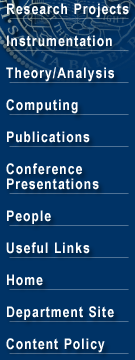 |

|
||||
|
The Sigma Program - Algorithm and Software Package Description The algorithm for the cross section calculations has been described in the literature.[3,4] It is sometimes referred to as the "projection model" and can be summarized as in the last paragraph of the Model section of ref. 4:
The radius of the circle drawn around each atom is either taken from a parameter file (hard sphere mode) or is calculated from Lennard-Jones parameters supplied by a second parameter file (Lennard-Jones mode). In the latter case the radii are temperature dependent.
Included are 8 files: 1
FORTRAN source file
The code is intended to be compiled under a UNIX platform. 1.) Make a copy of the source file and edit it, following the instructions mentioned in the head of the source file. 2.) Modify the call for the random number generation to match your system. This call is the only system-dependent call. The routine used in this version is for an IBM risc/6000. (SGI Indigo2 version available) 3.) Compile source code using a FORTRAN compiler. Use highest possible optimization to speed up execution.
For a list of options, run the programs by typing the name of the executable, e.g. sigma sigma The program will return the following information:
Usage:
sigma -i input_filename
Results
are unpredictable when more than one of the flags -p, -s, and -h are used!
To run the program type the name of the executable (e.g. sigma) and specify the coordinate file with the -i flag (default format is "mol2") and one of the flags -p, -s or -h with a parameter file name following:
sigma -i coord.mol2 -p parameters.dat
Other formats for the coordinate file are supported and can be specified by the -f flag. If AMBER crd- or trj-files are used the topology file is indicated by -a and the number of structures per file by -l sigma -i coord.xyz -f xyz -p parameters.dat
The accuracy (average deviation in %) can be given by -n (default 2)
There are 3 modes of operation: hard sphere mode, Lennard-Jones mode, and ion size scaled Lennard-Jones mode.
In the hard sphere mode the atomic radii are supplied in the file specified by the -p flag. A parameter file supplied for this mode is called "parameters.dat". The buffer gas radius can be given by -b
In the Lennard-Jones mode the parameters used are specified by the -s flag which automatically triggers the Lennard-Jones mode. Parameter files supplied and used with -s are "mm3.pot" and "adj.pot". The temperature is set in Kelvin by -t and is by default 300 K.
Two Lennard-Jones parameter files are provided. One (mm3.pot) contains parameters that are used in Molecular Mechanics (MM3), the other one (adj.pot) those that have been optimized to fit the experimental temperature dependence of the cross section. Before using any parameters please read and understand the following paper:
The third mode of operation, the "ion size scaled Lennard-Jones mode", is used in manner very similar to that described above. The only difference is that the L-J potential parameters are scaled to the size (number of atoms) of the polyatomic ion: the fewer atoms, the less buffer gas-ion interaction (the less deep the potential well). This mode is selected by the -h flag and the parameter file following. The parameter file supplied with the software package is called "sca.par".
The formats for the parameter files are different for each mode of operation and are described in the source code. |
||||